January 2011
These notes about the history of the Plant Breeding Institute (PBI) were prepared following a short talk to the meeting about Trumpington’s farming history ( October 2009 ) and are a personal perspective.
See also Plant Breeding Institute staff , c. 1972 and 1987 (Peter Reed).
A light hearted appreciation of the work of Sir Roland Biffen, Director the Plant Breeding Institute, depicted in the CUAS Magazine, 1926.
The Plant Breeding Institute (PBI) was established in 1912 as part of the Department of Agriculture in the University of Cambridge. The justification was the rediscovery of the Mendelian laws of inheritance and that these laws could be applied to crops of economic importance as shown by Sir Roland Biffen in 1906. Sir Roland had used this knowledge to produce the wheat variety Little Joss , released in 1910, that contained resistance to yellow rust derived from a Russian wheat. In fact Mendel’s work, released in 1865, describing his laws of inheritance, had not been lost and it may be the proponents of the PBI needed a “scientific” argument for its inception.
Sir Roland became the first director of the PBI. Work was initially devoted entirely to the breeding of improved varieties of wheat, particularly improved grain quality; resulting in the release of Yeoman in 1916 that set a standard for yield and quality until 1957.
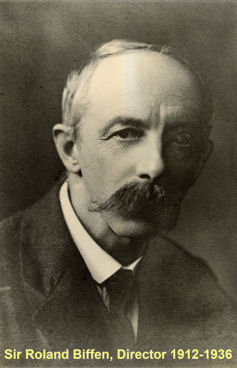
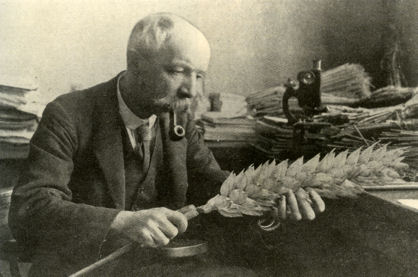
Sir Roland insisted that the breeding work should be based on sound scientific principles. This was borne out when the PBI was expanded after the First World War by the appointment of F.L. Engledow (later Sir Frank) as an additional wheat breeder, H. Hunter to work on oats and sanfoin and A.E. Watkins to study the genetics of wheat. Soon after this, the work expanded to include peas and barley. Although the work on peas did not make much impact, that on barley by G.D.H. Bell, although curtailed by the Second World War, led to the variety Proctor that was instrumental in tripling barley production between the 1950s and 1960s. Potato breeding commenced in 1939 and sugar beet in the 1940s; the latter because supply of seed from the continent had been curtailed by the Second World War.
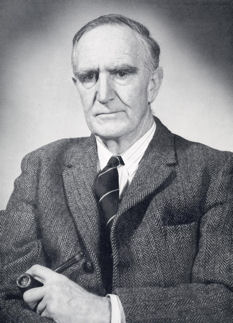
Dr G.D.H. Bell, Plant Breeding Institute. Source: Plant Breeding Institute.
After the Second World War, the national policy was to urgently increase agricultural and horticultural food production. It involved large increases in research at several institutes and research centres in Great Britain. The PBI with its history of practical breeding and applied research was well placed for expansion. In 1948 it was announced that the PBI was to be considerably expanded and it would be set up as a Research Institute within the Agricultural Research Council thus severing its link with the University. G.D.H. Bell was appointed its first director with a remit to research into the breeding of varieties of arable and herbage crops. In practice it meant that research findings and genetic material was freely available to anyone with the result that commercial breeding companies ultimately benefitted enormously and eventually competed with the practical work of the PBI.
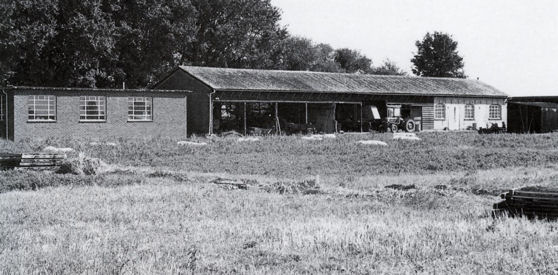
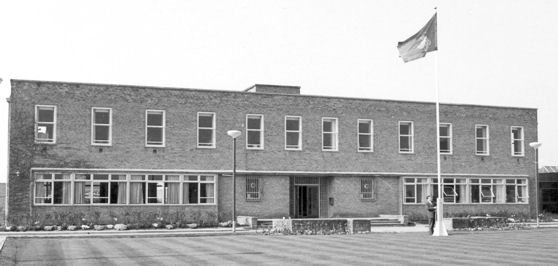
The Plant Breeding Institute Field Station, Cage Field, University Farm, Cambridge, c. 1952. Source: Plant Breeding Institute.
The front entrance to the Plant Breeding Institute headquarters building in Trumpington, Cambridge. Source: Plant Breeding Institute.
At that time the total complement of staff was 35 working on cereals, forage crops, potatoes, sugar beet and cytogenetics. Staff numbers and facilities thereafter rapidly increased such that by 1976 , 32 varieties of 14 different crops were on the Recommended List of the National Institute for Agricultural Botany for growing in the UK. In addition, 16 crops were being grown in 12 other countries, mostly in Europe but including New Zealand, USA, Canada and Iceland. Eighty one scientific papers were published in the previous year. By 1984 staff numbers had further increased.

The Plant Breeding Institute staff in 1954, taken at the entrance to the University Department of Agriculture, Downing Street, Cambridge. Source: Plant Breeding Institute.
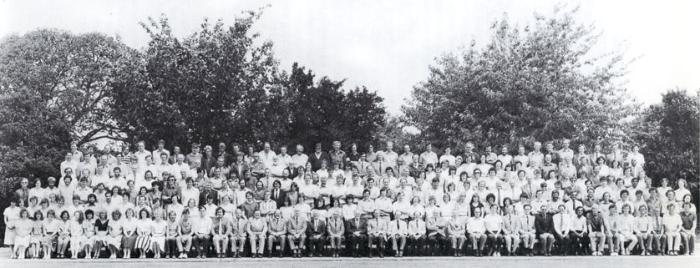
The Plant Breeding Institute staff in 1984. Photo: Edward Leigh.
A full account of the benefits to the UK and successes of the PBI are far beyond the scope of these notes. However, one profound development was the production of semi-dwarf wheat, initiated by Dr F.C. Lupton and further developed by J. Bingham. Another was the introduction of a series of bread-making wheats suitable for growing in the UK that reduced imports from ca. 3 million tons to ca. 0.5 million tons per annum. Yet another was the release of the potato Maris Piper by H. Howard and colleagues in 1966. Maris Piper has resistance to the soil borne cyst nematode species Globodera rostochiensis , an important pest of potatoes, particularly in the Fens. Maris Piper continues to be a great success on the domestic market and is probably the most widely known of any vegetable variety to date.
Four Queen’s Awards to industry were achieved: in 1973 for new, improved varieties of wheat; in 1975 for marrow stem kale; in 1982 for Maris Piper potatoes; and in 1987 for bread-making wheats. The last was presented by Princess Ann as part of the 75 years celebration.
The National Seed Development Organisation (NSDO) at Newton was set up to sell the plant based products of the research units in the UK. After prolonged negotiations the NSDO and PBI were ‘privatised’ in 1987; being purchased by Unilever plc. The sale excluded the basic research on cytogenetics, molecular genetics and plant pathology that was later transferred to the John Innes Centre at Norwich.
Thus the PBI no longer existed in name but Unilever developed the remaining commercially viable unit as ‘Plant Breeding International Cambridge’ (PBIC). Breeding successes continued; one notable example being the production of the wheat variety Consort . Initially aimed at the export market it also became the preferred soft milling wheat for the UK and is still grown for specialist markets such as breakfast cereals and health snack bars. Consort made a major contribution to the UK becoming a substantial exporter of wheat worth several billions of pounds sterling.
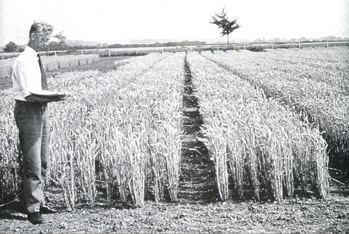
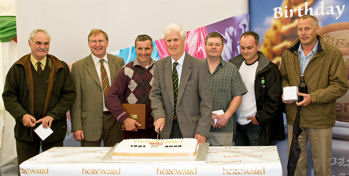
Dr Francis Lupton with semi-dwarf wheats, Plant Breeding Institute, Trumpington. Source: Plant Breeding Institute.
John Bingham with farmers celebrating 18 years of production of Hereward wheat, 2009. Photo: Stephen Brown.
Advertisement for Consort wheat. Source: Plant Breeding International Cambridge.
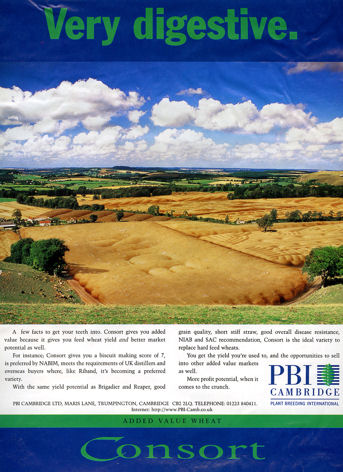
In 1998 Unilever sold PBIC to Monsanto, who gradually reduced the work and finally sold the last remaining crop to a French co-operative and the site to developers. Work started in early 2011 on building ca. 1200 dwellings on the land.


Demolition of the main building of the former Plant Breeding Institute in Trumpington, Cambridge, March 2009. Photo: Stephen Brown.
The last pieces of the former Plant Breeding Institute buildings being removed from the site, 2009. Photo: Stephen Brown.
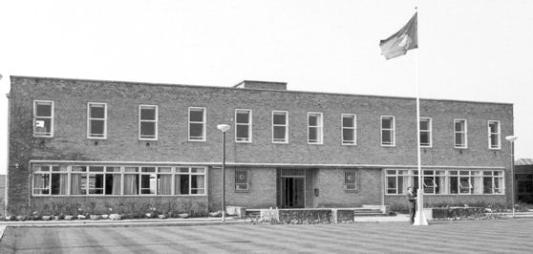
Sir Roland Biffen, Director of the Plant Breeding Institute, 1912-36.
Until 1948 the work of the PBI had been undertaken on the University farm, off Huntingdon Road, principally on Cage Field. Facilities at Cage Field were somewhat crude by modern standards and the opportunity would be taken to form a “state of the art” institute.
A new site in Trumpington was acquired in 1950 and work started in temporary buildings in 1952. There were delays in construction due to post-war shortages but by 1954 the main building was occupied and the new PBI was formally opened in 1955.
However, in the 1980s rationalization of the work at the UK agricultural and horticultural research centres (there were 23 ‘Institutes’ and 18 research units) was necessary and work on crops such as Lucerne, grasses, kale, clover and forage maize at the PBI was either stopped or transferred to other locations. Basic research continued with strong cytogenetics and molecular genetics departments that drew in the most capable staff and visiting research students from both the UK and overseas.